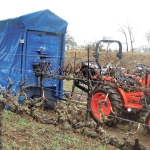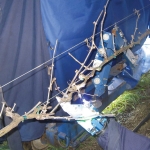Can a robot prune an apple tree?
The short answer, it seems, is yes. Give it some simple pruning rules, and it can do 90 percent of the work, reducing the human labor of dormant pruning to some minor touch-up.
In fact, a machine capable of pruning apple orchards may be commercially available within a few years. For a cost of about 50 cents a tree, it will be able to find the right branches and make the proper cuts without human assistance. It may even be self-propelled and self-guided, needing no human operator except to turn it around at the end of a row.
All that was explained during a lengthy workshop during the Mid-Atlantic Fruit and Vegetable Convention in Hershey, Pennsylvania, in January.
By way of background: In 2012 a group of horticulturists and engineers were awarded $3 million from the Specialty Crop Research Initiative, to be matched with institutional and industry funds, to develop automated pruning of grapes and apples.
The project landed at Purdue University in West Lafayette, Indiana, under the overall direction of horticulturist Dr. Peter Hirst. He had assembled the team that includes horticulturists Jim Schupp and Tara Baugher at Penn State University; electrical and computer engineers Johnny Park, Avinash Kak, and Noha Elfiky at Purdue; economist Jayson Harper at Penn State; sociologists Leland Glenna and Anouk Patel-Campillo at Penn State; Tony Koselka and Bret Wallach at Vision Robotics; and Julie Tarara from the USDA’s Agricultural Research Service in Washington State.
“The overall goal,” Hirst said, “is to develop a pruning machine that growers can buy.” It was not to be “pie in the sky,” he said. “It was supposed to be ‘rubber meets the road.’” The intention was to reduce the art and elevate the science of pruning.
Fruit growers spend about 20 percent of their labor on pruning vines and trees, Hirst said, and they rely on an ever-less-certain labor supply from the migrant workforce. Pruning is not as large a labor investment as harvest, and timing is not as critical, but pruning rates high on a grower’s list of time-consuming tasks.
Some work done
The people at Vision Robotics in San Diego, California, had already developed a prototype grapevine pruner, so much of the work had been done on imaging—using cameras and computers to locate canes—and on the actual robotic arms that move the clippers, Edward Scissorhands style.
A tractor pulls the machine over a row of grape vines while cameras capture images of the vines and a computer remembers cane locations and tells robotic arms where they are. Pruning grapes is relatively simple, since each cane is cut back to one or two buds.
The grape prototype needed perfecting—one of the goals of this project—but the basic technology was there and was applicable to apples, Hirst said. “Apple trees are more complex and will take more time,” he said. “But once we have that, it should be much smaller steps to translating the work for other fruits such as plums, peaches, and cherries.”
Koselka, with Vision Robotics, said he thought the company would have a grape pruning machine ready for market in 18 to 24 months.
“It’s an amazing time for mechanization,” he said. The robot arms, with the flexible shoulders, elbows, and wrists, move as effectively as a human arm, but they now cost about $45,000 each. “We want to get that down to $10,000,” he said, and thought that would happen, particularly since there is currently so much interest in the medical world in developing better artificial limbs for people.
To develop the tree system, Hirst worked with Park and Kak, in Purdue’s department of electrical and computer engineering, who are building digital 3-D models of trees and designing software.
“The challenge is to accurately construct 3-D models of trees and vines and program that in such a way that the computer can determine the optimal points to prune. Our goal is to make this work at a speed that makes sense financially for growers,” Park says.
As a first step to automated pruning of apples, there have to be some rules to prune by. Schupp, the Penn State pomologist, set to work to provide those. Although pruning is often considered an art, not a science, Schupp was surprised how easy it was to develop rules.
He made eight rules—steps that a human pruner would take in pruning a tree. Then, examining them, he found that four rules really covered it all pretty well. And, on further examination, he wrote one rule that he believes covers 70 percent of the job.
First, however, he had to select a tree to prune.
“I chose the tall spindle single axis system,” he said. “It is the world’s standard tree today.”
Besides its early, high productivity and top quality fruit, growers like the tall spindle system because it makes pruning easier with its renewal pruning concept, in which larger branches are removed completely, almost on a schedule.
Here are the eight rules as Schupp originally wrote them:
1. Once the leader reaches 14 feet, head it to a short side branch by cutting into two- and three-year-old wood to maintain a tree height of 11 to 12 feet.
2. Maintain a narrow cone shape by thinning out shoots that are more than 30 inches long in the top.
3. Remove any secondary limb when its diameter becomes more than half the diameter of the leader or more than 1.5 inches in diameter, whichever comes first.
4. Remove two, three, or four (your choice) of the largest side branches remaining, leaving a short duckbill stub.
5. Remove all damaged or diseased limbs.
6. Thin otherwise good branches, spacing them out to reduce the number of secondary branches to 30 to 60, depending on your yield expectations.
7. Remove all other vertical shoots with an angle of less than 40 degrees.
8. Prune each remaining side branch to a single axis, either by thinning away tertiary branches that are more than half the diameter of the secondary branch or by stubbing the drooping limb back to a new axis. This step also eliminates pendant limbs.
After looking at the rules, Schupp noted that 70 percent of the pruning could be done following one rule only, rule number 4: Remove the two to four largest limbs. Add rule number 7, taking out vertical growing limbs, and the job is 90 percent done, he said.
He did not think that rule number 1 could be trusted to a robot.
“Don’t let a robot touch that leader,” he said. “Do it manually.”
“Will a robot be capable of making a bevel-shaped stub cut?” someone asked, at which time Schupp answered, “Does it matter?” There is no research, he said, to show that a tree makes a better replacement branch under a bevel, or Dutch cut, than under or above a square stub cut.
“Some Dutch guy back in 1968 said it was better, but presented no data, and we just went with it. Does it matter? The key is to leave the collar and a limb will grow,” Schupp said.
Last first
Schupp noted that pruning severity also needs to be addressed, and that starts with the number of large limbs selected for removal. The idea is to tell the machine (or person) to remove the largest limb first and then move to the next largest limb, in order.
He conducted research to determine how yield and fruit quality respond to pruning. He concluded that a limb-to-trunk-size ratio of 1.25 seemed ideal. In other words, taking the trunk cross-sectional area and increasing it 25 percent gives a number that is the ideal cross-sectional area of all the limbs growing off the trunk.
The more limbs that are removed, the greater the pruning severity, and the lower the ratio. Yield is reduced when the number gets closer to 1, and fruit size and quality is reduced when the number gets up to 1.75, Schupp found.
That ratio still needs to be modified, he said, because as trees get older the trunk will become larger, but the limbs should not be allowed to become permanent scaffolds. So the ratio will increase as the trunk gets larger.
Modeling the tree
Elfiky, the Purdue engineer, explained what her team did after Schupp gave them the pruning rules. They used sensors to determine the shape of the tree, the location of its limbs, and the size of the limbs and leaders, and made a model of the tree.
As it turned out, a few cheap sensors, costing about $200 each, were capable of generating a computer picture of the tree. Telling the machine to remove the three largest limbs was simple.
If a machine for pruning trees is developed along the same lines as the Vision Robotics grape pruner, the machine will likely move from one tree to another, scanning the next tree in line as it moves. Then it will stop, the arms will move, the shears that are its “hands” will make the cuts, and the machine will move to the next tree, scanning it as it moves.
“This research has caused us to examine things we never really thought about,” Hirst said. A seasoned horticulturist with 30 years experience, he recalled the hundreds of pruning demonstrations where one expert would make cuts and explain why, and another would do something completely different.
Hirst thinks that Schupp’s pruning rules will not only help robots, they will help humans. You can do 70 percent of the pruning and get 90 percent of the benefit by making 8 to 10 cuts, Schupp said.
People or robots can do that. •
ONLINE
Information about the project can be found at the website pruningautomation.com








Leave A Comment